

How to Understand and Appreciate Classical Music
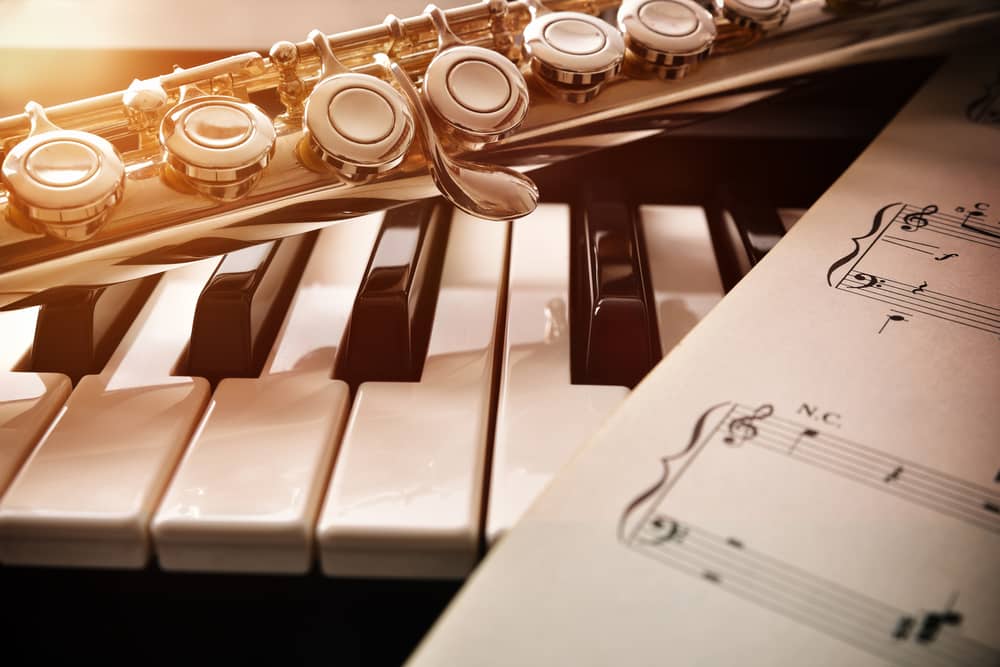
Classical music covers a very broad span of music from the Medieval to the present day. Each era of music has its unique characteristics and idiosyncrasies. To find your way towards a richer appreciation of a thousand years of musical and cultural history is no modest undertaking, but there are a few options I am about to suggest that I hope will help.
One route I have found successful, in a teaching capacity at least, has been to listen to a variety of classical music and see which piece inspires you or evokes some kind of emotional response. If there is a particular instrument, voice, or ensemble that you enjoy the sound of, this could help narrow down the selection process. My first instrument was the piano, and so I found myself interested to know more about Beethoven or Mozart. It was this interest that spurred a deeper appreciation of classical music in general.
From this humble beginning, I began to read about the composers I liked and tried to understand how they did what they did. Part of my reason for this was to be able to perform the pieces I enjoyed in a manner close to what the composer intended. As I was also beginning to compose music too, I wanted to see behind the notes and know why these great classical composers chose the notes they did and put them together in the way that they did. In a sense, this academic approach to understanding Classical music was something that suited me and provided me with a foundation of musical knowledge that allowed me to eventually study music at university.
Appreciation of Classical music , just the same as an appreciation of Jazz or Popular Music does not have to involve years of study but can be tackled on a much more friendly footing. Tuning in to a radio station like Classic FM can be an excellent starting point. Often the music is briefly introduced by the presenter with a few choice facts about the music, then part or all of the work is played. This particular station I mention as the selection of music tends towards the more well-known and popular side of the Classical repertoire that may be an engaging and approachable way to get further into Classical music.
In the top ten Classical pieces , there is ‘Eine kleine Nachtmusik’ (K.525) by Mozart;
‘Für Elise’ by Beethoven;
‘Toccata and Fugue in D minor’ by JS Bach;
and the ‘Symphony No.5’ by Beethoven.
These pieces have been popular for hundreds of years because there is something about them, amongst many other classical works, that appeals to a huge amount of people. Trying to fathom out why these compositions appeal on such a large scale can bring about a fuller understanding of the music itself. This, in turn, can give rise to a more fulfilling listening experience.
Before we delve further into the practicalities of this I must emphasize that listening is key. This may appear like an obvious thing to point out, but music is rarely just listened to. It often accompanies us at the gym, underscores a movie or advertisement, and is heard but not truly listened to. If you try to listen hard to any piece of music, the music begins to reveal its innermost secrets.
By this I refer to subtle changes in dynamics or expression; harmonies; the rise, fall, and phrase of a melody; changes in ensemble or textures, or rhythms, motifs, and tempo (speed), of the piece. These musical elements are not things that we are encouraged to listen for. Much popular music these days may provide a singable melody with a supporting repetitive beat but it does not invite deeper appreciation unless you are a production enthusiast, and that is another story. Popular music is designed to provide a background to our activities whereas Classical music, I would argue, has more to listen for and if you wish your appreciation to develop, listening deeply is a fine place to start.
Classical music can be reduced to background music and in fact ‘Eine kleine Nachtmusik’, was broadly intended by Mozart to be just that. But, this does not mean that the music has nothing below its surface; it does, and here is where the journey into the piece begins. If you listen, you begin to pick out more details. The melody on the opening movement, which is so popular, is a rising arpeggio figure that features in this section of the work. It is in a major key. The speed of the piece is quick (allegro), and the opening melody is played by unison strings. At first, this is challenging, but break down the listening into different elements.
Start by focusing on what is often the more dominant feature of a piece of music; the melody. Listen to the ‘shape of the melody’ and perhaps which instrument or voice has the melody. Does it swap maybe from one instrument to another? Listen again to the pieces, trying this time to hear the speed (tempo) of the music, and any repeating rhythmic ideas that maybe there. With the next listening, you could focus on the changes in volume (dynamic), to see what you hear. Are some instruments louder than others? At what volume does the melody start and end? Does it remain the same throughout this passage?
These are suggestions that would benefit from a little theoretical knowledge as well as concentrated listening. Knowing, for example, the names and sounds of orchestral instruments would be helpful. Being aware that music is often a melody plus an accompaniment (homophonic), so you can identify both parts of what is being played. Some music involves more than one melody, common in Baroque music , and this would be called polyphonic. A sketch in your mind of the characteristics of the period of music you are listening to will provide a backdrop of key elements to listen out for. You could make a brief tick list to help out.
Ultimately, a combination of contextual, theoretical, and practical musical knowledge will develop your appreciation more quickly. Patience is essential as it takes time and focus to gain musical understanding and allow your listening skills to grow. It goes without saying, but a passion for the music you are listening to will greatly assist your exploration of the wonders of Classical music.
Leave a Comment
Discover the Top 75 Free Courses for August

Udemy Announces Layoffs Without Saying ‘Layoffs’
Udemy’s latest ‘Strategic Business Update’ uses corporate euphemisms to signal job cuts while pivoting to enterprise clients.
- 10 Best Applied AI & ML Courses for 2024
- 7 Best Sketch Courses for 2024
- 8 Best Free Geology Courses for 2024
- 7 Best Climate Change Courses for 2024: Exploring the Science
- [2024] 110+ Hours of Free LinkedIn Learning Courses with Free Certification
600 Free Google Certifications
Most common
- digital marketing
Popular subjects
Artificial Intelligence
Programming Languages
Cybersecurity
Popular courses
Shakespeare Matters
AP® Microeconomics
Greening the Economy: Sustainable Cities
Organize and share your learning with Class Central Lists.
View our Lists Showcase
Class Central is learner-supported. When you buy through links on our site, we may earn an affiliate commission.
Introduction to Classical Music
Yale University via Coursera Help
- What Is Music?
- Every day around the world, billions of people listen to music of one sort or another, and millions listen to Western classical music. Why do we do it? Because it’s fun? Because it energizes or relaxes us? Because it keeps us current, allows us to understand what’s happening in past and popular culture? The pull of music--especially classical music—has never been explained. The aim of this course is to do just that: To explicate the mysteries and beauties of some of Western cultures greatest musical compositions—among them masterpieces of Bach, Mozart, Beethoven, Wagner, and Puccini. We begin with the elements of music, breaking classical musical into its components of pitch, duration, and sound color, allowing us to better understand how music works. Next, we proceed to the compositions themselves, starting with the Middle Ages and Renaissance, to show how Western music developed in ways unique to the West. Ultimately, we reach the masters, commencing with Bach. What makes his music great? Why does it move us? What should we listen for? And so we proceed down through Western musical history, visiting virtually the people who created it and the places where they did so. By the end, we hope all of us have become more human (enriched our personalities) and had a rollicking good time!
- How Music Works, it's Magic.
- What is Music? Is music simply the organization of sounds and silences passing through time? Or is it more? Poet Victor Hugo believes music is "what feelings sound like." In this first module, we’ll take apart Hugo’s seemingly simple statement by spending some time asking how and why music induces strong emotions in people across different cultures. We’ll begin with a look at the inner workings of the human ear to determine how our brains process sound waves. Then, we’ll travel to different parts of the world, comparing and contrasting both traditional and popular Western music with sounds from various regions and cultures. You’ll find that it is both culture and the physics of music that determine why we like the music we like! From there, we’ll be ready to take a look at the basic elements of musical composition; rhythm, melody, texture, etc. We’ll also learn how classical composers used these elements in some of their most famous works and how modern artists are still using them today. Finally, we will see how the elements of musical composition have evolved over time and how they have been translated to a universal language enjoyed and understood by millions.
- The Sound of Music
- Have you ever wondered what it is that makes music sound sometimes rich and luxurious and sometimes strange and mysterious? Well, you’re in luck because this module, we’ll explore what the nature of simultaneous sounds and textures. We’ll start off with a look at chords, specifically how the three types of triads– tonic, dominant, subdominant– build a foundation upon which a melody can be constructed. Once we understand the rules of musical syntax, we’ll be ready to learn about musical progressions including the three types of cadences.We’ll also look at major and minor triads and how they work. Then, we’ll learn how to hear the bass and focus on the harmony of a song. Finally, I’ll talk you through the four families of musical instruments–brasses, percussions, strings, and woodwinds---and the various musical textures, forms, and styles that they can create. How exciting!
- Music Back in the Day
- We will cover a thousand years in musical evolution during this modules lectures! We'll start with the Middle Ages taking a look at its functional chants and dance music, then we’ll move to the period of the Renaissance, and finish off by listening to the ornate melodies of opera heard throughout the early Baroque period. From this, you’ll begin to see how advances in musical notation allowed compositions to become both more specific and more complex. These advances are ultimately responsible for focus being shifted away from the performers and towards the composers themselves.Along the way, we’ll highlight some of these musical inventors and innovators, such as Hildegard of Bingen and Johann Pachelbel. We’ll also have the unique opportunity to see (and in some cases even hear) many of the instruments that were popular during these different time periods. This will be a real treat, made possible with help from Yale instructor, Grant Herreid. Many thanks are owed to him!
- The Baroque Era
- Novelists, poets, painters, mathematicians, and even geologists talk about "fugue-like" structure in their media and disciplines. But what is a fugue and how did we get it? To find out, we enter the world of Baroque music and famed master of the fugue, Johann Sebastian Bach. First, we'll get a chance to "live" during the Baroque period by taking a detailed look inside the life, career, and even home of Bach-- explore where and how Bach and his family lived, discuss Bach’s music, and talk about the techniques of Baroque music as a whole. Next, Bach’s music will then be compared and contrasted with that of his exact contemporary and fellow German, George Frideric Handel. One might say that Bach was an idealist and Handel was a realist when it came to music, so we’ll look at how these personality traits informed each composer’s musical style. Finally, we'll wrap up the module with an introduction to music of the Classical Period, and who better to lead the way than the inimitable Wolfgang Amadeus Mozart?
- The Classical Era
- Would you believe that once upon a time, musical compositions were viewed as disposable, one-time-use entertainment? Could you imagine an orchestra attempting to perform a beautiful piece over the sounds of noisy patrons in a casino? How about a violin being drowned out by a dog loudly barking outside of a café? Well, this was the reality before the turn of the 18th century. It wasn’t until around 1800 that people began to appreciate musical compositions, as they do today. This was the same time we started to see large concert halls created specifically for the purpose of listening to concerts. Not long after, music was seen as something to be elevated and studied, in other words it became, “High Art.” This week, we’ll start by listening to music by Haydn and Mozart, getting our grounding, so to speak, in musical form. As we proceed, we'll also see where and how they lived, compare how they wrote and performed their music, and even look at some of the exact instruments they performed on all those years ago.We’ll spend latter part of the module highlighting two figures that stand at the very heart of Western music.The first is Mozart, a well-dressed, confident, eccentric, and ever brilliant innovator. We’ll explore his music through the lens of three artistic masterpieces: a piano concerto, an opera, and the Requiem mass... We’ll delve into the unique features of the music that make it the gold standard for all music for centuries to come. Perhaps the high (or low) point arrives when your instructor is ruthlessness murdered on stage by the feckless Don Giovanni.We’ll then shift over to Beethoven– a passionate, conflicted, and oft-times disheveled genius. His physical appearance may very well have served as the prototype for the stereotypical, “struggling bard,” or “tortured genius.” We’ll study some of his most famous sonatas, including his Moonlight Sonata and then go beyond his music to explore his personal life, including his struggle with deafness and depression.
- The Bridge From Classical to Romantic
- If you could put a soundtrack to the French Revolution, it would surely contain music from Beethoven's "Heroic" period, during which, he “brought sound to symphonies.” We’ll see how Beethoven’s incorporation of new instruments, as well as, his creation of a large orchestra, made his symphonies much louder and "sonically vivid" than those of his predecessors. The point of focus here will be a comparison of the music of Beethoven's "Heroic" period, represented by his Symphony No. 5, with that of his "Late" period, epitomized by his famous Ode to Joy. We'll also consider Beethoven the man, as revealed through primary source accounts of his life at that time. They paint a picture of a disheveled, wild-looking Beethoven, who lived among filth and clutter and was consumed by his work. The ultimate question: in what ways might his life of isolation and his hearing disability affected the nature (style) of the great music he created?As we bid aufwiedersehen to Beethoven, we move on to full-blown musical Romanticism. Romantic music, and indeed all romantic art, was known for its idealistic views on love and nature. Occurring roughly from 1820 to 1900, musical Romanticism saw an evolution of musical style as well as a change of venue (place) for musical performance. In addition to the aristocracy and their royal palaces, a strong middle class arose in Europe during this period. With the music of the ever-lyrical Franz Schubert, we'll step into the parlor of an upper-middle class home, to experience his domestic chamber music and songs. We’ll finish off the module by asking the question: How do we use musical sound to communicate? A look at program music (instrumental music that uses musical gestures to tell a story) will help us figure this out. After a quick auditory review of the workings of program music (we'll follow Vivaldi on a spring day), we'll watch Hector Berlioz go to hell. More accurately, we’ll follow the sequence of musical gestures he employs to re-create a fantastical tale of pursuit, destruction, damnation. Having learned our lesson, we’ll end with a little fun as we try to match themes extracted from various symphonies to the mental images that the composer had in mind. Do you speak the language of program music fluently? Join us and find out!
- The Romantic Era
- Module 8 will begin with a tour of Yale’s extraordinary keyboard collection; perhaps the finest of its kind in the world. We’ll see fully functioning instruments of all shapes and sizes, some dating back to the time of Mozart and before! We’ll learn the preferred brands and styles of some of the finest pianists of all time, Haydn, Beethoven, Liszt, Chopin, and Schubert to name a few. We’ll even get to hear some of these instruments played by musical educator and concert pianist Robert Blocker. His performances will help us hear exactly how advances in technology changed the sound and capabilities of pianos during this time period. Our next session this module covers a rather polarizing topic: Opera. Many people find the Opera too artificial, too long, and sometimes just plain boring; others enjoy nothing more than this glamorous art form. We’ll spend some time making a case for the power and beauty, indeed the magic, of Opera. Maybe, we’ll be able persuade some naysayers along the way. Because it is impossible to encompass all of Romantic opera in an hour, we'll concentrate on the masterpieces of Verdi and the groundbreaking music dramas of Wagner. Perhaps the only figure who can reasonably by compared to Beethoven in terms of musical originality and innovation, Wagner changed the face of 19th century music. We’ll explore Wagner by briefly analyzing his Ring Cycle. This innovative cycle of librettos, based on Norse mythology, contains some of the most iconic and recognizable music from the period. Wagner's use of "leitmotifs” made detailed storytelling possible, with the music even conveying the subconscious thought of singers on stage, a truly revolutionary feat. His work would go on to serve as inspiration for writers and film makers such as Tolkien, Lewis, Lucas, and Martin, not to mention countless composers. In the final lesson of this module, we’ll expand our focus to look at the orchestra as a whole during the Romantic period. Just 60 years after Mozart led his thirty-five-player orchestra, it was not uncommon to see Wagner and Mahler conducting ensembles with well over 100 members. In addition to increased numbers, the instruments themselves changed. Technological advances, transformed previously one dimensional instruments, such as the French horn, into versatile tools, capable of projecting a completely chromatic melody. This newfound versatility allowed composers like Brahms and Mahler to experiment with and forever redefine orchestral instrumentation.
- Music to the Present
- When you think of Impressionism, you probably think of paintings, likely the beautiful canvases of Claude Monet. But the emotionally evocative, non-realistic style of Impressionism pervaded all aspects of art. For music, another Claude, this time Debussy, typified the Impressionist movement. After learning about the sometimes outrageous lives of some of history’s famous composers, it may shock you to hear that Debussy led a rather banal existence, with no depression, psychosis or family tragedy to speak of. But from an ordinary life can come extraordinary music! We’ll look at three pieces, one each from his early, middle, and late career, to see how Debussy's style shifted away from more goal-oriented Romanticism to the “live in the moment” style that came to define Impressionism. After a brief guitar lesson taught with the help of the talented Solomon Silber, we’ll continue on to the Modernist period. As is well known to all by now, musical style is constantly changing. Sometimes the change is subtle, like the shift from Classical to Romantic music. At other times, however, change crashes like a Tsunami against previous traditions. This is what we experience as we engage the bracing sounds of Modernism. Beginning in the early 20th century, composers such as Igor Stravinsky and Arnold Schoenberg abandoned traditional melody and scale. Simply put, audiences were, at times, less than receptive to this change. We’ll listen to samples of the music that provoked audience hostility, and discuss what seems to make this music so inaccessible, at times downright unpleasant, for most listeners.We will close this week, and our course, with Postmodernism and Minimalism. We’ll see how composers like Aaron Copland brought orchestral music back to the people by paring it down to its most basic terms. We’ll then hear how artists such as Philip Glass and John Adams, took this idea and ran with it, composing captivating trance-like movements around the simplest of ideas.
Craig Wright
- united states
Related Courses
Classical sonatinas and sonatas at the piano, the piano sonata: origins to mozart, intro to music for teachers: professional development, uexcel introduction to music: study guide & test prep, introduction to music: certificate program, orela music: practice & study guide, related articles, ivy league online courses, 1700 coursera courses that are still completely free, 250 top free coursera courses of all time, massive list of mooc-based microcredentials.
4.7 rating, based on 25 Class Central reviews
4.9 rating at Coursera based on 3921 ratings
Select rating
Start your review of Introduction to Classical Music
- AA Anonymous 9 years ago This is one of the best courses I have taken so far. The educator teaches in a correct way all the elements regarding the understanding the classical (an even general) music and forms of art. I consider this course very hard, especially because there are a lot of materials to learn from. I created a document where I kept my notes and it is +47 pages long. But don't get me wrong, it is a course for total beginners. Even though, I would take it again. Helpful
- DR Dave Rawlings 7 years ago I'm the most unmusical person in the world (so my wife says), and had no knowledge of classical music before starting the course. I found some of it challenging, especially the sections that concentrated on the technical aspects of the music. Nevertheless I felt I gained a lot, now have a little knowledge, and enjoyed the course. The professor's approach is very engaging and covers the historical development very well. Helpful
- Pam Gould 8 years ago I thought I was going to learn a bit about western classical music, but I learnt an huge amount about 'music' as a whole. Craig Wright is an engaging and enthusiastic teacher. He has inspired me to learn more about medieval music. I've downloaded the course and have referred to it many times when studying other music MOOCs. Brilliant! Helpful
- AA Anonymous 4 years ago I am currently taking this course and can not get enough of it! He explains everything in depth so that you gain a proper understanding of classical music, its differences to pop music and many other things. a great course taught by a great teacher! Helpful
- NV Natalie Vaughan 6 years ago An excellent, comprehensive well presented introduction to western classical music. Highly recommended for anyone interested in increasing their knowledge of classical music! Helpful
- RS Rachel Schultz 9 years ago This is a great course, especially for music lovers. Very interesting. The teacher is understandable, and the music sounds great! Helpful
- AA Anonymous 4 years ago Truly an exhilarating and outstanding experience. Our Professor and Guide took us through the sessions through excellent historical research as well as well designed acoustic and virtual presentations. His beautifully structured theoretical insights introduced the uninitiated to the musical mysteries and opened the fantastic world of Western Classical music to the students. Highly recommended for all music lovers. Helpful
- Christopher Gidley 4 years ago Great introduction to classical music. Does not assume any prior knowledge (but it can help if you have some). Starts at the beginning of written music to progress all the way to the present time (post-modern era). Talks about the major composers within 24 hours (although a few major ones are left out, but can be found in his book). Highly recommend! Helpful
- LA Lada A. 3 years ago Great opportunity to learn about classical music from a masterful teacher, who provides the music theory, cultural history and more needed to really appreciate the pieces as he guides you through the centuries. Helpful
- AA Anonymous 4 years ago I did misstage. I dont want to Begin this class. English Language i too difficult for me. I have not started, but had to buch ”taking right now ” to het this letter away. 2020.05.28 Helena Perkkalainen Helpful
- JA Joseph Alagbe 4 years ago I have really been longing to take an online course on music buy am very poor to sponsor myself and I will be happy if I can be sponsored and taught well and also be given a certificate. Helpful
- AA Anonymous 4 years ago Se ve muy interesante el curso, pero veo que es en ingles y pues me parece mal que solo esté en un idioma no da la opción de tomarlo por falta del manejo de este. Helpful
- Anne Elder 8 years ago Helpful
- ZV Zorica Vasic 7 years ago Helpful
- AB Anastasia Blita 9 years ago Helpful
- EA Emilia Alquist 7 years ago Helpful
- MT Mak Shiu Kwong Thomas 7 years ago Helpful
- DJ Deepak Jois 9 years ago Helpful
- DG Dimitri Gurewitsch 9 years ago Helpful
- HA Henry Alvarado 8 years ago Helpful
Never Stop Learning.
Get personalized course recommendations, track subjects and courses with reminders, and more.
- Collections
Entertainment
- Classical Music PowerPoint Presentation
Classical Music Google Slides and PowerPoint Template
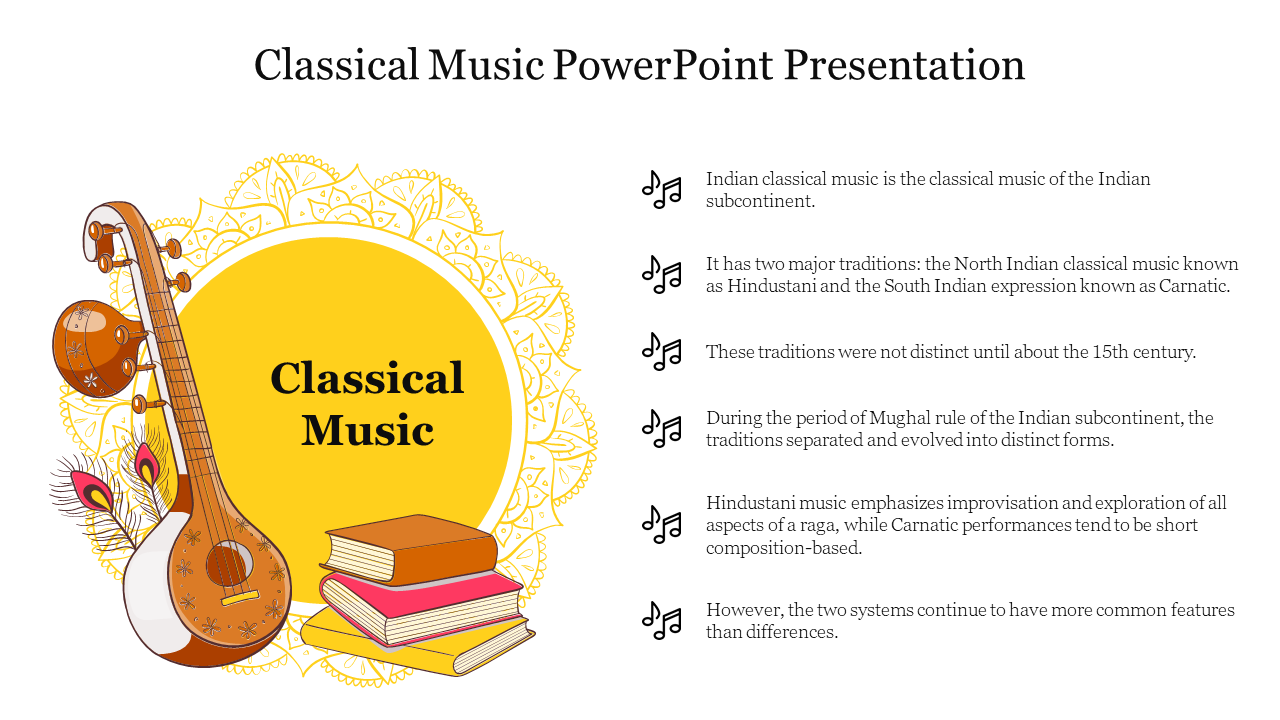
Classical Music Presentation
Features of this template:.
- 100% customizable slide and easy to download.
- Easy to change the slide's colors.
- The template is available in both 16:9 and 4:3 formats.
- Highly compatible with PowerPoint and Google Slides.
- Music Theme
- Music Playlist
- Music Composition
- Musical Performance
- Music Concert
- Musical Icons
- Music Notes
- Music Infographics
- Music Notes Style
- Google Slides
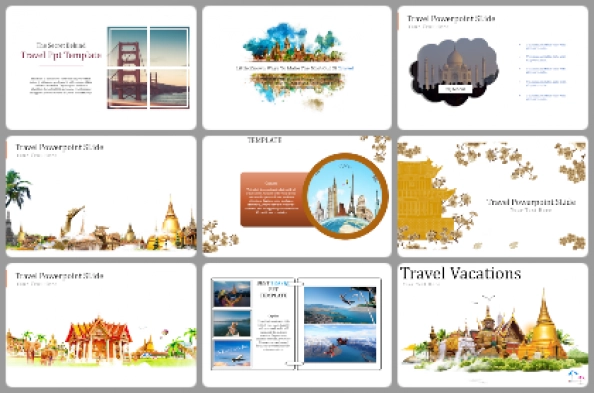
158+ Templates
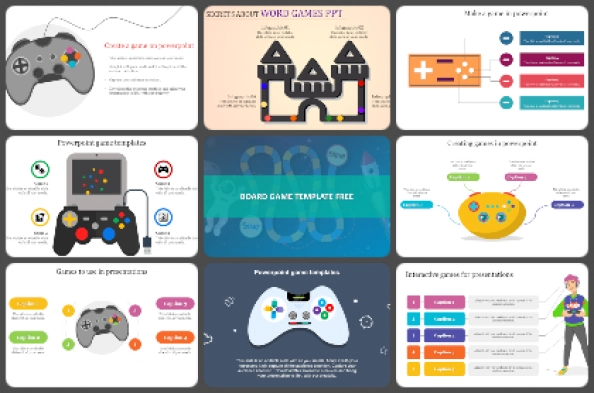
176+ Templates
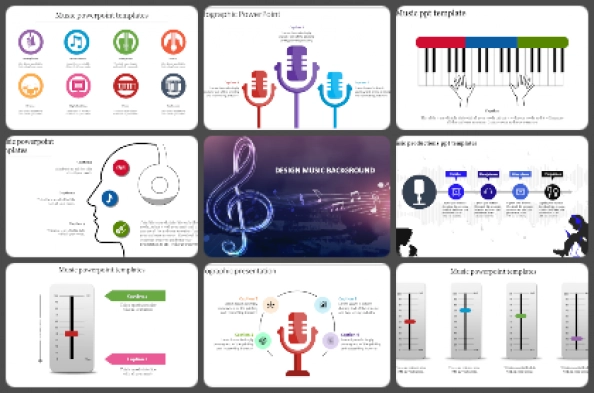
184+ Templates
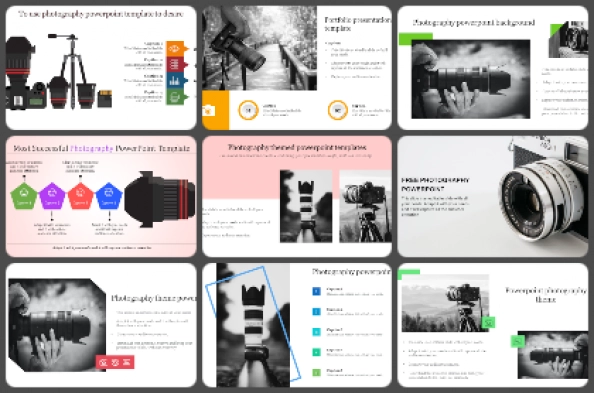
Photography
43+ Templates
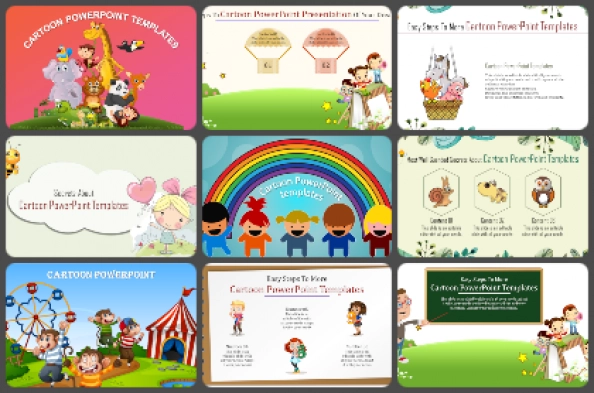
119+ Templates

61+ Templates
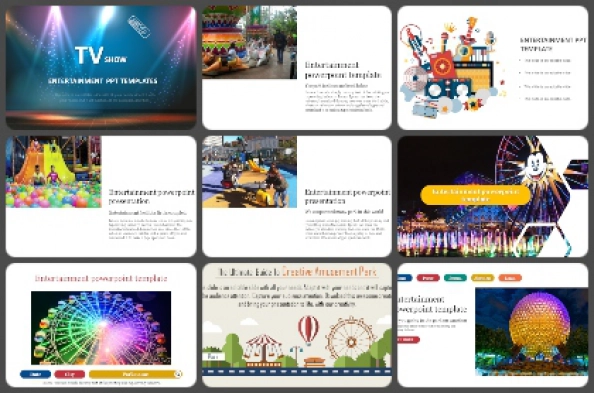
78+ Templates
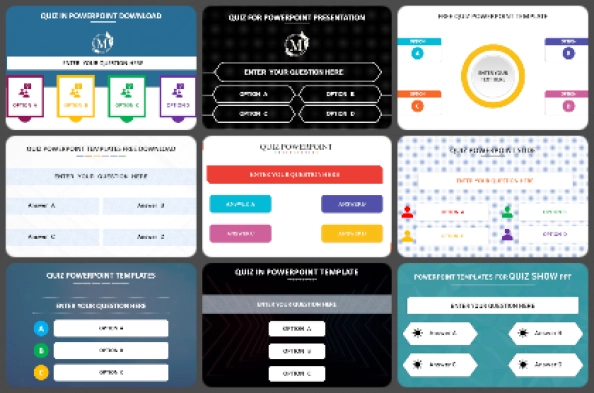
Quiz Templates
26+ Templates
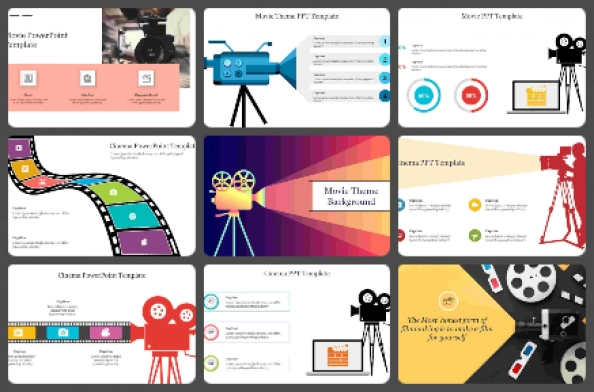
77+ Templates

24+ Templates
You May Also Like These PowerPoint Templates


Create moving, zooming presentations that grab attention and keep it.

Appear right alongside your content while presenting to your audience.

Make stunning interactive charts, reports, maps, infographics, and more.
You're about to create your best presentation ever
Classical Music Powerpoint Templates
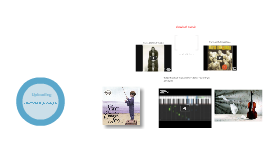
classical music
Transcript: classical music from jazzy types too.. To blues type music these types of music were hits for more than 20 years! too one of my personal favorites, a piano type classic old people are old :o thanks for watching!
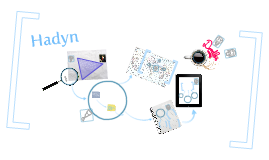
CLASSICAL MUSIC
Transcript: he wrote 106 symphonies (cc) photo by Franco Folini on Flickr hadyn was born on 31 of march 1732 and died on the 31 may 1809. he had illness in 1802 and it got worse he then passed away in 1809 before napolen invaded vienne. (cc) photo by Metro Centric on Flickr Vienna joseph haydn was a conductor he wrote classical music and compossed it him self Research he was 77 when he passed Results haydn had no children Notes (cc) photo by Metro Centric on Flickr was his home Hadyn facts of haydn (cc) photo by jimmyharris on Flickr Haydns Birth And Death

PowerPoint Game Templates
Transcript: Example of a Jeopardy Template By: Laken Feeser and Rachel Chapman When creating without a template... http://www.edtechnetwork.com/powerpoint.html https://www.thebalance.com/free-family-feud-powerpoint-templates-1358184 Example of a Deal or No Deal Template PowerPoint Game Templates There are free templates for games such as jeopardy, wheel of fortune, and cash cab that can be downloaded online. However, some templates may cost more money depending on the complexity of the game. Classroom Games that Make Test Review and Memorization Fun! (n.d.). Retrieved February 17, 2017, from http://people.uncw.edu/ertzbergerj/msgames.htm Fisher, S. (n.d.). Customize a PowerPoint Game for Your Class with These Free Templates. Retrieved February 17, 2017, from https://www.thebalance.com/free-powerpoint-games-for-teachers-1358169 1. Users will begin with a lot of slides all with the same basic graphic design. 2. The, decide and create a series of questions that are to be asked during the game. 3. By hyper linking certain answers to different slides, the game jumps from slide to slide while playing the game. 4. This kind of setup is normally seen as a simple quiz show game. Example of a Wheel of Fortune Template https://www.teacherspayteachers.com/Product/Wheel-of-Riches-PowerPoint-Template-Plays-Just-Like-Wheel-of-Fortune-383606 Games can be made in order to make a fun and easy way to learn. Popular game templates include: Family Feud Millionaire Jeopardy and other quiz shows. http://www.free-power-point-templates.com/deal-powerpoint-template/ Quick video on template "Millionaire" PowerPoint Games Some games are easier to make compared to others If users are unsure whether or not downloading certain templates is safe, you can actually make your own game by just simply using PowerPoint. add logo here References Example of a Family Feud Template PowerPoint Games are a great way to introduce new concepts and ideas You can create a fun, competitive atmosphere with the use of different templates You can change and rearrange information to correlate with the topic or idea being discussed. Great with students, workers, family, etc. For example: With games like Jeopardy and Family Feud, players can pick practically any answers. The person who is running the game will have to have all of the answers in order to determine if players are correct or not. However, with a game like Who Wants to be a Millionaire, the players only have a choice between answers, A, B, C, or D. Therefore, when the player decides their answer, the person running the game clicks it, and the game will tell them whether they are right or wrong.
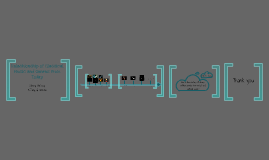
Classical Music
Transcript: Music from today will always reflect certain time periods and cultural events a song may have pieces of old music to update it the new song of today 1683-1764 Jean-Philippe Rameau http://8tracks.com/docellis/classical-dubstep ` 1397-1474 Guillame Dufay end 1700s-1800s enlightenment 1098-1179 Hildegard von Bingen http://beamsandstruts.com/bits-a-pieces/item/840-saturday-night-jukebox-classical-music-in-dubstep Thank you 2000 Hip Hop 1935 Rock and Roll ... small Ashley, Chrissy, Tiffany, & Antonio 1935s Jazz Relashionship of Classical Music and Genres from Today 2002 Dubstep
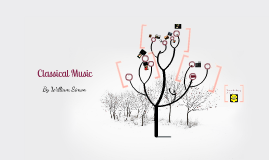
Transcript: Classical Music By William Simon Thanks For Paying Attention ! In my personal opinion the best composer of the Classical Era was Ludwig Van Beethoven. Although he did not compose hundreds of pieces he did compose nine amazing and internationally renounced pieces which are enjoyed everyday by the men and women of the world who have a passion for Classical Music. Wolfgang Amadeus Mozart Franz Joseph Haydn Made from Western Liturgical and Secular Music Lasted From 1750 – 1820 Usual works were Concertos, symphonies and sonatas Major factor in development of music notation Although this may sound ridiculous Classical music is proven to be one of the most effective ways of making infants brains develop. A Harvard graduate studied the reactions brains have when a child listens to classical music and compared it to say rap. Classical music is proven to help increase memory and IQ level in mainly infants but can also minutely increase it in adults Christopher Gluck is know as the man who started Opera or changed it 100%. Gluck revolutionized opera by softening the contrast between melodic themes and orchestral passages. He wrote his notes in line with the opera's words similar to how modern movie makes make movie scripts and he also brought together French and Italian operatic styles. Favorite Composer Classical Music is arguably the first real type of music. Although Classical Music spams for hundreds of years the Classical Era of music brought froward dozens of famous composers who we still appreciate. It is suggested that the notation system we use for music began to develop in this time. Salieri may have been jealous of Mozart's musical genius, but the rumors of Salieri killing Mozart with poison although would be awesome are false.. Salieri was a respected composer who was most know for his contributions to opera, but stopped composing operas in 1804 and then started composing only church music. Salieri was friends with Haydn and gave music composition lessons to Beethoven. The Effects Of Classical Music Ludwig Van Beethoven Half of Mozart's life as he said was wasted on touring Europe and composing countless pieces. Born in 1756 Mozart began composing at the age of five. After he toured with his father Mozart died at the age of 35. Yet during his short life Mozart greatly advanced classical period music with over 600 compositions. His style is closely related to that of Haydn's but more radical and was accused for being too long and having too many notes. You Tube http://en.wikipedia.org/wiki/Classical_music http://www.npr.org/music/genres/classical/ http://www.classical.net/ http://www.naxos.com/education/brief_history.asp http://library.thinkquest.org/16020/data/eng/text/education/theory/history.html Bibliography Antonio Salieri Classical Music Many view Beethoven as the man connecting the classical period to the romantic period. Beethoven only wrote nine symphonies. Compare that to Haydn and Mozart who together wrote over 150 symphonies it makes Beethoven look like he did nothing which is simply not true. What makes Beethoven special was his successful attempt to break the mold of the strict rules of the classical period. His compositions especially Symphony number nine opened the gates to composing with feelings. Haydn was a remarkable composer, epitomizing classical music, and though he wasn't as cool as the Mozart when he was young, his music was always exactly what Classical Music should be like. Haydn, unlike most composers, had a predictable job. Haydn composed, directed, tought, performed, and managed musicians from the royal family. During this time, Haydn composed many pieces of music for the local orchestra to perform. With a large amount of work, including over 100 symphonies and 60 string quartets, he is often called the "Father of the Symphony". Christoph Willibald Gluck Classical Musics Inspiration on The World Of Music
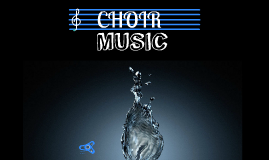
Transcript: MUSIC CHOIR Topic I think this is about facts! I think this is about feelings! I think this is about data! Different perspectives
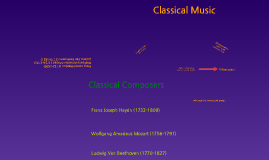
Transcript: Classical Music Simplicity, logic, and order Still dependent upon royal sponsors, but... Lower classes & the musically uneducated Ticket sales! Skilled performers in public eye Classical Composers Franz Joseph Hayden (1732-1809) Wolfgang Amadeus Mozart (1756-1791) Ludwig Van Beethoven (1770-1827) Franz Joseph Haydn (1732-1809) "Father of the Symphony" Symphony String Quartet Piano Trio Prince Esterhazy Rondo form Ludwig Van Beethoven (1770-1827) Wolfgang Amadeus Mozart (1756-1791)

Transcript: Classical Music Top 3 classical composers W.A.Mozart W.A.Mozart stands for wolfgang Amadeus Mozart which was his real name. Wolfgang Amadeus Mozart was born to Leopold and Anna Maria Mozart. J.Haydn Joseph Haydn was born in Rohrau, Austria, a village near the borderwith Hungary. His father was Mathias Haydn, a wheelwright who also served as "Marktrichter",an office akin to village mayor. Beethoven Ludwig van Beethoven remains one of the most famous and influential of all composers. Ludwig van Beethoven is beethovens real name. Classical music facts Classical music is the art music produced in, the traditions of Western liturgical and secular music, emerging broad period from roughly the 11th century to present times. The instruments used in most classical music were largely invented before the mid-19th century (often much earlier). Famous composers From left to right: Top row – Antonio Vivaldi, Johann Sebastian Bach, George Frideric Handel, Wolfgang Amadeus Mozart, Ludwig van Beethoven; second row – Gioachino Rossini, Felix Mendelssohn, Frédéric Chopin, Richard Wagner, Giuseppe Verdi; third row – Johann Strauss II, Johannes Brahms, Georges Bizet, Pyotr Ilyich Tchaikovsky, Antonín Dvořák; bottom row – Edvard Grieg, Edward Elgar, Sergei Rachmaninoff, George Gershwin, Aram Khachaturian By Holly Alee and Abbie Composers and performers alike are typically highly literate in understanding notation.
Explore our templates for more presentation inspiration

Sales KickOff - Rocket
Description: The sky’s the limit. Boost your new sales initiative into orbit with an engaging and compelling SKO presentation. This template features a effective sales kickoff theme that makes it easy to be engaging. Like all Prezi SKO templates, it’s fully customizable with your own information.

Quarterly Business Review - Downtown
Description: Add some color to your quarterly business review with this vibrant business presentation template. The bold visuals in this business template will make your next QBR a memorable one.

Customer Stories - Office
Description: Storytelling is at the heart of great service. Use this stunning, customizable business presentation template to highlight employees who do exceptional work or position your customers as the heroes of your business.

Marketing Proposal Template for Powerful Presentations | Prezi
Description: Catch the eye and engage the imagination with this cool-looking Prezi proposal template. The bold, bright design and highly dynamic theme all but guarantee success for your next sales or marketing proposal. All Prezi presentation templates are easily customized.
Now you can make any subject more engaging and memorable
- The Science
- Conversational Presenting
- For Business
- For Education
- Testimonials
- Presentation Gallery
- Video Gallery
- Design Gallery
- Our Customers
- Company Information
- Prezi Support
- Prezi Classic Support
- Hire an Expert
- Data Visualization
- Infographics
July 25, 2024
July 22, 2024
July 18, 2024
- Latest posts
© 2024 Prezi Inc. Terms
Slidesgo.net is an independent website that offers free powerpoint templates and is not part of Freepik/any particular brand. Read the privacy policies
classical music Powerpoint templates and Google Slides themes
Discover the best classical music PowerPoint templates and Google Slides themes that you can use in your presentations.
Pianist musician piano music playing PowerPoint Templates
Slidesgo categories.
- Abstract 13 templates
- Agency 15 templates
- All Diagrams 1331 templates
- Brand Guidelines 3 templates
- Business 195 templates
- Computer 66 templates
- Education 97 templates
- Finance 54 templates
- Food 57 templates
- Formal 60 templates
- Fun 6 templates
- Industry 91 templates
- Lesson 67 templates
- Marketing 57 templates
- Marketing Plan 19 templates
- Medical 71 templates
- Military 21 templates
- Nature 119 templates
- Newsletter 5 templates
- Real Estate 46 templates
- Recreation 53 templates
- Religion 30 templates
- School 557 templates
- Simple 5 templates
- Social Media 8 templates
- Sports 46 templates
- Travel 26 templates
- Workshop 4 templates
Slidesgo templates have all the elements you need to effectively communicate your message and impress your audience.
Suitable for PowerPoint and Google Slides
Download your presentation as a PowerPoint template or use it online as a Google Slides theme. 100% free, no registration or download limits.
Want to know more?
- Frequently Asked Questions
- Google Slides Help
- PowerPoint help
- Who makes Slidesgo?
Music for Presentation + Classical
- modern classical
- classical piano
- Editors' Choice
- Bestsellers
- New Featured
- Hidden Gems
Link copied to clipboard Copy Link Facebook X E-mail
- AI Powered Search
- On Hold Music
- Music For Podcasts
- Music For Presentations
- Music For Slideshows
- All Time Bestsellers
- Free Music Downloads
- How it Works
- License & Pricing
- License Agreement
- Terms of Service
- Privacy Policy
- Our Composers
- Sell Your Music
- Share full article
Advertisement
Supported by
Esa-Pekka Salonen: A Conductor at the Top, and at a Crossroads
Salonen, who will soon be a free agent for the first time in decades, could do pretty much anything at this stage. What will it be?

By Joshua Barone
Reporting from Stockholm and New York
On a late afternoon in May, pop and classical music luminaries gathered in the neo-Gothic sanctuary of a 19th-century church-turned-Soho House in Stockholm. With drinks in hand, they listened as the media personality Cilla Benkö asked Esa-Pekka Salonen, “So what’s going on in your head at the moment?”
“Well, I’m at a crossroads,” said Salonen, the composer and conductor, who is a year away from becoming a free agent for the first time in decades. “I’m kind of figuring out what to do, if anything.”
Salonen is in a good position to choose what comes next. He is a conductor at the top of his field, and the kind of composer who can bring on not just one high-profile commissioner but several for each new piece he writes. The day after his interview with Benkö, he received the Polar Music Prize , an honor that has been called the Nobel Prize of music, directly from the hands of the Swedish king.
The award is given to a classical and a pop artist annually; Salonen’s counterpart was Nile Rodgers, the mind behind songs like “We Are Family” and “Le Freak” and albums by Madonna, David Bowie and Beyoncé. Guests at the ceremony included the royal family, the megaproducer Max Martin and a member of ABBA, all gathered for a televised evening of tributes and black-tie diners dancing in the aisles to music related to the prize winners.
With royalty grooving to Daft Punk but also listening attentively to Salonen’s “Concert Étude for Solo Horn,” it was a fitting celebration for Salonen, one of the most open-minded, open-eared and fundamentally cool artists in classical music, who at 66 is beloved and respected across the field.
We are having trouble retrieving the article content.
Please enable JavaScript in your browser settings.
Thank you for your patience while we verify access. If you are in Reader mode please exit and log into your Times account, or subscribe for all of The Times.
Thank you for your patience while we verify access.
Already a subscriber? Log in .
Want all of The Times? Subscribe .

Bruckner's magnificent finale self.__wrap_n=self.__wrap_n||(self.CSS&&CSS.supports("text-wrap","balance")?1:2);self.__wrap_b=(t,n,e)=>{e=e||document.querySelector(`[data-br="${t}"]`);let s=e.parentElement,r=O=>e.style.maxWidth=O+"px";e.style.maxWidth="";let o=s.clientWidth,u=s.clientHeight,a=o/2-.25,l=o+.5,d;if(o){for(r(a),a=Math.max(e.scrollWidth,a);a+1 {self.__wrap_b(0,+e.dataset.brr,e)})).observe(s):process.env.NODE_ENV==="development"&&console.warn("The browser you are using does not support the ResizeObserver API. Please consider add polyfill for this API to avoid potential layout shifts or upgrade your browser. Read more: https://github.com/shuding/react-wrap-balancer#browser-support-information"))};self.__wrap_n!=1&&self.__wrap_b("undefined",1)
Log in to share your opinion with YourClassical and add it to your profile.
Thanks for liking this song! We have added it to a personal playlist for you.
Anton Bruckner's Symphony No. 8 is a massive piece—more than 80 minutes from beginning to end. Conductor Yannick Nezet-Seguin says the symphony is akin to entering a vast canyon. As you listen to Bruckner, he says, "Accept that space and time are different. It is not about the micro event but the grand line. Just breathe in, breathe out, and feel the connection of that music to the harmony of the universe." Join us to hear conductor Yannick Nezet-Seguin lead the finale to Bruckner's Symphony No. 8 at the Lucerne Festival in Switzerland.
Episode Playlist
Karim Al-Zand: Visions from Another World: Movement 3 ROCO | Mei-Ann Chen, conductor Album: Visions Take Flight Innova 1016 Anton Bruckner, arr. Robert Haas: Symphony No. 8 in C minor: Movement 4 Lucerne Festival Orchestra | Yannick Nezet-Seguin, conductor Lucerne Festival, Concert Hall KKL, Lucerne, Switzerland Luigi Boccherini: Guitar Quartet No. 4 in D Major, G. 448: Movements 3-4 Dolce Suono Ensemble: Gideon Whitehead, guitar | Mimi Stillman, piccolo | Christine Lim, violin | Burchard Tang, viola | Thomas Kraines, cello and castanets DSE Presents, Trinity Center for Urban Life, Philadelphia, PA Jonathan Peters: Arthropod Suite ROCO | Jeri Lynne Johnson, conductor ROCO, St. John the Divine, Houston, TX
Alfredo Casella: Berceuse triste Op. 14 Anna Geniushene, piano Album: Berceuse Piano Classics PCL10279 Gary Kuo: In Remembrance Lviv National Philharmonic of Ukraine | Benjamin Loeb, conductor Lviv National Philharmonic of Ukraine, Ukrainian National Academic Theater, Lviv, Ukraine Joseph Haydn: Sonata in D Major, Hob. XVI:42 Anna Geniushene, piano Van Cliburn International Piano Competition, TCU Van Cliburn Concert Hall, Fort Worth, TX Amy Beach: Piano Quintet in F-sharp minor, Op. 67 Pedja Muzijevic, piano | Livia Sohn, violin | Benjamin Beilman, violin | Gabriela Diaz, viola | Nina Lee, cello Spoleto Festival USA Chamber Music Series, Dock Street Theatre, Charleston, SC
Love the music?
Show your support by making a gift to YourClassical.
Each day, we’re here for you with thoughtful streams that set the tone for your day – not to mention the stories and programs that inspire you to new discovery and help you explore the music you love.
YourClassical is available for free, because we are listener-supported public media. Take a moment to make your gift today.
More Ways to Give
Your Donation
Latest performance today® episodes.

2024 Classical Woman of the Year: Deborah Borda
‘Performance Today’ has selected performing-arts advocate Deborah Borda as the 2024 Classical Woman of the Year. This annual award recognizes women who have made significant contributions to the classical music art form and have inspired our listeners. Find out more!

Bruckner's magnificent finale


Stewart Goodyear: Panorama
Trinidad is the home of the steel drum—or the steel pan as it's called locally. Every year at Carnival, Trinidad hosts Panorama, a showcase for the best steel pan ensembles. Composer and pianist Stewart Goodyear plays his take on Panorama on this episode of Performance Today.

PT Weekend: The Sound of Light
For composer Jennifer Higdon, a commission isn't just about who pays for the piece; she views commissioning music as a way to empower people to share their voices and celebrate their communities. We'll learn more and hear the Merian Ensemble play Higdon's "The Sound of Light" on today's show.

Elfrida Andrée
Swedish composer and organist Elfrida Andrée was determined to do it all. She advocated for legal changes so women could work as organists and telegraph operators, and she wanted people to know that women could compose significant works. We'll hear Elfrida Andrée's Symphony No. 2 on this episode of Performance Today.

Avery Gagliano
We're pleased to introduce one of our 2024 PT Young Artists in Residence: pianist Avery Gagliano. On today's show, Avery joins Fred Child for music and conversation at our Saint Paul studio.

Jennifer Higdon: The Sound of Light

James Ehnes and the Grand Teton Music Festival
Violinist James Ehnes absolutely loves playing at the Grand Teton Music Festival. He says, "The physical beauty is beyond description, and the quality of music-making defies rational explanation." On today's show, we'll take you to Jackson Hole, Wyoming, to hear Ehnes play Max Bruch's Violin Concerto No. 1.

Ani and Marta Aznavoorian
The Aznavoorian sisters gave their first concert at a local church when cellist Ani was four and pianist Marta was eight. Ani and Marta have each grown up to have successful careers, and now, they're sharing a stage again. Join us to hear sisters Ani and Marta Aznavoorian play at a concert presented by the Flagler Museum in Palm Beach, Florida.

PT Weekend: Certified organic
In 2022, the Apollo Chamber Players commissioned a work by composer Wang Jie. Wang Jie, also trained as an organist, wrote the piece for the unusual combination of pipe organ and string quartet. On today's show, we'll hear the Apollo Chamber Players and organist Daryl Robinson play the world premiere of The Night When You See Again by Wang Jie.
About Performance Today®
To find a station near you on our Stations Listings page, click here .
American Public Media’s Performance Today® is America’s most popular classical music radio program and a winner of the 2014 Gabriel Award for artistic achievement. The show is broadcast on hundreds of public radio stations across the country, including at 1 p.m. central weekdays on Minnesota Public Radio. More information about our stations can be found at APM Distribution . Performance Today® features live concert recordings that can’t be heard anywhere else, highlights from new album releases, and in-studio performances and interviews. Performance Today® is based at the APM studios in St. Paul, Minnesota, but is frequently on the road, with special programs broadcast from festivals and public radio stations around the country. Also, each Wednesday, composer Bruce Adolphe joins host Fred Child for a classical musical game and listener favorite: the Piano Puzzler.
How do I leave a comment?
Send us a comment here .
We can help you find classical music you'll love
- Take a 2 minute quiz to share your taste
- We'll recommend YourClassical programming just for you
- Discover the power and joy of classical music

More From Forbes
From classical it to ai jazz. time to get some lessons.
- Share to Facebook
- Share to Twitter
- Share to Linkedin
International jazz day.
It’s all-digital now, from how you operate your company, to how you design your products and services, to how you attack the marketplace. None of this is new. It’s been true for at least a decade, though there are still companies that refuse to believe that they’re technology companies, which every company is in 2024 — and forever.
In fact, way, way too many executives still believe their companies can be run as a set of distributed functions shared with a variety of outside partners. Imagine how many partners there often are, and how challenging it is to manage multiple contracts? Not to mention the number of interdependencies across providers. Just remember that one single configuration file update recently crashed half the world . Can AI help reduce the chaos of IT and add strategic advantage? Yes, it can.
AI (machine learning and generative AI) completes the business-technology merger – even if some companies fail to see it. Tactical due diligence around the next big data analytics project or your next foray into multi-cloud-based solutions misses the point entirely. This is all strategic now. Operational technology is fully commoditized. It provides no competitive advantage. Competitive advantage only exists with strategic technology, and the clear winner here is AI.
AI is the strategic change that analysts, vendors, consultants, CIOs, CTOs and CEOs still often fail to see. (We collected some data in 2023 and 2024 that—incredibly—describes a lukewarm commitment to AI.) This is not incremental. It’s one of those pivots—like what we saw with the internet—that companies see, or they don’t, the kind of pivots that allowed companies like Uber, Airbnb, VRBO, PayPal and Stripe into the game as major players in vertical industries and essential infrastructure providers to all things transactional. OpenAI and Nvidia are there now, along with old-school technology vendors like Microsoft, Meta and Google, all trying to pivot before their customers pivot somewhere else. Yes, the war is on.
Note that the lane the internet opened has opened for AI—and then AI opened its own lane. But this one is far wider and impactful than the internet ever was. In fact, while the internet was an enabling technology that led to all sorts of new business models, AI is both an infrastructure and an applications platform that rides on the internet and its own large language models (and simpler models powered by everyday algorithms like regression).
Today’s NYT Mini Crossword Clues And Answers For Tuesday, August 13
Trump vs. harris 2024 polls: harris expands lead in latest survey, musk-trump x interview: trump takes friendly questions from musk after glitch-plagued start, the sounds of music.
Imagine the journey a musician might take from classical to jazz. Once upon a time, technology—when done well—was classical music, the same way that finance, accounting and HR—when done well—were classical. We thought about “IT” that way for years. We compared it to other business functions and processes, which in the 20th century was appropriate. But while accounting, finance and HR have obviously changed, they’re still more classical than jazzy. Technology, on the other hand, morphed into something that bears no resemblance to its 20th century self. It moved from the back office to the front office, took over the building, connected the world and then stood up and looked around for more things to do. The classical-to-jazz journey converts old classical fans to jazz ones—the full and forever integration of business and technologists.
Listen to this:
“Classical performances are traditionally based on pre-composed material, revitalizing scores from years past; whereas jazz is fresh with each performance with musicians extemporaneously re-composing in real time through the use of improvisation.”
The switch from classical to jazz assumes that business-technology is a concert with very different music than the concerts you’ve probably attended. Digital technology—powered by AI—is the last, and ongoing, improvisation. As more and more operational technology is commoditized in the cloud, leverage lies in the strategic application of emerging technology to current and future business processes and models prioritized by how much they impact current and future products, services and markets. AI is the maestro.
Business processes and whole business models must change, not just adapt: incrementalism-by-default is the enemy, in spite of how much safe political capital it generates. You must improve them, automate them, or just kill them altogether. But what do you replace them with? Which technologies make this happen? Which are irrelevant to your primary and adjacent markets—and markets you cannot even see today? Do you know how all this works—together? Or how it will work next year? AI will change just about everything. While we just entered the normal “trough” about the ROI around AI, be careful not to be seduced away from the unlimited potential of machine learning and generative AI. It’s all jazz now. You have no choice but to adapt even if you’ve been classically trained, which most companies have been over decades. It’s not like learning how to play golf left-handed. It’s about learning a whole new sport whose moves and rules bear no resemblance to the sports you play. It’s like learning how to play the French horn in a month, not the bongos you’ve already outsourced. AI’s a French horn. It’s complicated but capable of some of the most beautiful music you’ve ever heard.
Lessons — And Commitment
Let’s assume you’re given no choice, that you’re told you must learn how to read music and then play the French horn. Where do you start? You first need to assess how musical your team is. You then need to hire some good instructors. You need some instruments. You need it all. But most of all you need commitment, which according to some data we recently collected suggests that most companies are not fully committed to AI. Only 20% of companies defined “AI” initiatives as high priority, and over 47% defined them as insufficient or unknown. Consistent with this finding, only 25% adequately fund their AI initiatives and 37% believe they do “sometimes,” while 37% reported that their AI initiatives are not adequately funded or they just don’t know! If there’s no commitment, you’re going to have to somehow motivate your team to appreciate the complexities of AI jazz. Without commitment you’ll be stuck with the same old beautiful classical music you’re been listening to for decades. Beautiful, quiet and complacent—and that’s how it ends.

- Editorial Standards
- Reprints & Permissions
Join The Conversation
One Community. Many Voices. Create a free account to share your thoughts.
Forbes Community Guidelines
Our community is about connecting people through open and thoughtful conversations. We want our readers to share their views and exchange ideas and facts in a safe space.
In order to do so, please follow the posting rules in our site's Terms of Service. We've summarized some of those key rules below. Simply put, keep it civil.
Your post will be rejected if we notice that it seems to contain:
- False or intentionally out-of-context or misleading information
- Insults, profanity, incoherent, obscene or inflammatory language or threats of any kind
- Attacks on the identity of other commenters or the article's author
- Content that otherwise violates our site's terms.
User accounts will be blocked if we notice or believe that users are engaged in:
- Continuous attempts to re-post comments that have been previously moderated/rejected
- Racist, sexist, homophobic or other discriminatory comments
- Attempts or tactics that put the site security at risk
- Actions that otherwise violate our site's terms.
So, how can you be a power user?
- Stay on topic and share your insights
- Feel free to be clear and thoughtful to get your point across
- ‘Like’ or ‘Dislike’ to show your point of view.
- Protect your community.
- Use the report tool to alert us when someone breaks the rules.
Thanks for reading our community guidelines. Please read the full list of posting rules found in our site's Terms of Service.
University of Minnesota Morris
- Twin Cities
- Request Info
- What Is a Liberal Arts and Sciences Education and How Will It Benefit You?
- Small Classes; Big Rewards
- Low Cost; High Value
- Student Success
- A Community that Cares
- Student Community
- Sustainability & Green Living
- Student & Campus Life
- Degree in Three
- Internships
- Study Abroad
- Research and Creative Activity
- Visit Campus
- Majors, Minors, & Academic Programs
- Areas of Concentration
- Online Learning
- Division of Education
- Division of the Humanities
- Division of Science and Mathematics
- Division of the Social Sciences
- Honors Program
- Summer Term Tuition and Fees
- Truckers & Turnover Project
- Wind STEP Program
- How We Evaluate Applications
- Apply as a Transfer Student
- Apply as a PSEO Student
- Apply as an International Student
- Apply as a Returning Student
- Transferring Credit
- Family and Supporters Guide
- New Student Welcome Week
- Contact Admissions
- Net Price Calculator
- Scholarships
- Grants & Waivers
- American Indian Tuition Waiver
- Community of Scholars
- Residential Life
- Events & Activities
- Dining Facilities
- Student Employment
- Student Organizations
- Student Engagement at UMN Morris
- Intramurals
- Morris Campus Student Association
- Student Success Center
- Hasselmo Language Teaching Center
- Sports & Fitness
- Equity, Diversity & Intercultural Programs
- Native American Student Life
- Native American Student Success Program
- International Students
- LGBTQIA2s+ Support
- Multi-ethnic Student Program
- Accessibility Support
- Transportation Options
- Student Complaints and Grievances
- Student Affairs Office
Magic, ballet, Broadway and classical music included in UMN Morris's 2024-25 Performing Arts Series
The University of Minnesota Morris announces the 2024–25 Performing Arts Series presented by the Campus Activities Council (CAC). This season features performances by AnnaRose, Ballets with a Twist, Broadway’s Next Hit Musical, and ProMusica Minnesota.

Saturday, October 5, 7:30 p.m. | Edson Auditorium
AnnaRose, a Las Vegas magician with a touch of Iowa charm, wows crowds with her spellbinding acts at prestigious spots such as the Magic Castle in LA. Her shows in Sin City have earned her accolades, and her magic has graced top TV shows like Masters of Illusion and The Today Show, where her blend of wit, versatility, and audience rapport shine through.
Ballets with a Twist
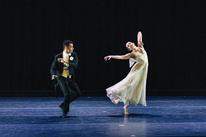
Saturday, October 26, 7:30 p.m. | Edson Auditorium
Cocktail Hour: The Show is a lively, visually stunning night-on-the-town experience. Watch as "Manhattan," "Martini," mocktail "Shirley Temple," and more spring off the menu and onto the stage in a series of dazzling vignettes. Suitable for audiences of all ages, the fun and fast-paced show transports theatergoers through time and around the world with original choreography, music, and costume design.
This event is hosted by UMN Morris Chancellor Janet Schrunk Ericksen, and thanks to a generous donation from an anonymous donor, the performance is free and open to the public. Chancellor Ericksen will also host a reception before the performance in Oyate Hall. No tickets are needed for this performance, and seating will be available on a first-come, first-served basis.
Broadway’s Next Hit Musical

Friday, February 21, 7:30 p.m. | Edson Auditorium
Broadway's Next Hit Musical is the ultimate stage showdown where viewers get to play director by tossing in song ideas for "The PHONY Awards." Watch as improvisers work their magic, turning these ideas into award-worthy tunes and crafting an entire impromptu musical around the winning song. Get ready for a wild ride filled with on-the-spot scenes, toe-tapping tunes, dance breaks, laughter, and even a chance for the audience to join in on the fun!
ProMusica Minnesota

ProMusica Minnesota Artistic Director and pianist Bethel Balge returns to Morris with a program of timeless classics plus…a grand tango. Minnesota Orchestra’s Principal Clarinetist Gabriel Campos-Zamora and Associate Principal Cellist Silver Ainomäe join forces with Balge to present traditional fare–trios by Beethoven and Brahm and a heady cocktail–Le Grand Tango by Astor Piazzolla. Piazzolla’s Grand Tango was written in 1982 for cello and piano, melding tango rhythms with jazz-inspired syncopation. Come and experience chamber music at its best!
Season and individual event tickets are available for purchase online at z.umn.edu/performing-arts-series , over the phone from 10 a.m. to 5 p.m. at 320-589-6077, or in person at the Office of Student Engagement & Events on the Morris Campus, located on the lower level of the Student Center.
UMN Morris Campus News & Events
Submit a story idea
For Media/Experts
For the media
Submit an event to the campus calendar
- Anishinaabe Summer Language Immersion

- Health A to Z
- Alternative Medicine
- Blood Disorders
- Bone and Joint
- Cardiovascular Diseases
- Child Health
- Coronavirus
- Dental Care
- Digestive System
- Disabilities
- Drug Center
- Ear, Nose, and Throat
- Environmental Health
- Exercise And Fitness
- First Aid and Emergencies
- General Health
- Health Technology
- Hearing Loss
- Hypertension
- Infectious Disease
- LGBTQ Health
- Liver Health
- Men's Health
- Mental Health
- Pain Management
- Public Health
- Pulmonology
- Senior Health
- Sexual Health
- Skin Health
- Women's Health
- News For Medical Professionals
- Our Products
- Consumer News
- Physician's Briefing
- HealthDay TV
- Wellness Library
- HealthDay Living
- Conference Coverage
- Custom Products
- Health Writing
- Health Editing
- Video Production
- Medical Review
Brain Study Shows How Classical Music Lifts Your Mood
Key takeaways.
Classical music lifts a person’s mood by improving brain connections
The music caused stronger interactions between regions related to sound and pleasure
Adding low-frequency sound to music increased people’s enjoyment of it
MONDAY, Aug. 12, 2024 (HealthDay News) -- Does listening to classical music make you feel sublime?
A new study suggests there might be a scientific reason for that: Researchers discovered that the music lifts a person’s mood by improving connections between brain regions related to both sound and pleasure.
How? Music synchronizes brain waves between the auditory cortes, which processes sound, and the rewards circuit that processes emotional information, according to findings published Aug. 9 in the journal Cell Reports .
The study focused on a brain circuit connecting two areas of the forebrain -- the bed nucleus of the stria terminalis (BNST) and the nucleus accumbens (NAc)
A group of 13 patients with treatment-resistant depression already had electrodes implanted in this circuit for the purpose of deep-brain stimulation, researchers explained.
“The BNST-NAc circuit, sometimes referred to as part of the ‘extended amygdala,’ underscores the close relationship between this circuit and the amygdala, a central structure in emotional information processing,” said senior researcher Dr. Bomin Sun , director of the Shanghai Jiao Tong University’s Center for Functional Neurosurgery.
In the study, patients listened to the third movement of Beethoven’s Symphony No. 7, “representing joy and excitement,” researchers wrote in their paper.
Electrode scans revealed that the music boosted the flow of brain waves through this circuit, researchers reported.
They also found that altering the music slightly could improve the patients’ response to it.
For example, inserting low-frequency theta noise into music increased patient’s reported enjoyment, results showed.
Theta frequency sounds are associated with the lightest stage of sleep and can induce a meditative effect, according to the Sleep Foundation.
The research team next plans to study the interaction between music and the deep structures of the brain. They also want to introduce other sensory stimuli, including visual imagery.
“By collaborating with clinicians, music therapists, computer scientists and engineers, we plan to develop a series of digital health products based on music therapy, such as smartphone applications and wearable devices,” Sun said in a journal news release.
“These products will integrate personalized music recommendations, real-time emotional monitoring and feedback, and virtual-reality multi-sensory experiences to provide convenient and effective self-help tools for managing emotions and improving symptoms in daily life,” Sun added.
More information
The Sleep Foundation has more on theta waves and binaural beats .
SOURCE: Cell Press , news release, Aug. 9, 2024
What This Means For You
Classical music can improve a person’s mood by stimulating the interaction between the brain’s sensory and reward systems.
Related Stories

Billie Eilish, H.E.R., Red Hot Chili Peppers and Snoop Dogg to perform in the LA28 handover celebration at the Closing Ceremony of Olympic Games Paris 2024

Picture by 2024 Getty Images
LA28 has revealed the all-star musical lineup for the LA28 handover that will take place at the finale of the Paris 2024 Closing Ceremony on Sunday, 11 August.
Artists including the Grammy and Academy Award-winning Billie Eilish , Grammy-winning Red Hot Chili Peppers and Snoop Dogg , Southern California music icon, will perform in the celebration. Grammy, Academy and Emmy Award-winning artist H.E.R. will perform the U.S. national anthem live in Paris.
"This is the biggest moment in LA28 history to date, as the Olympic flag passes from Paris to LA,” said LA28 Chairperson Casey Wasserman. “We are thrilled to feature the very best of LA with local artists and are grateful to Billie, H.E.R., the Chili Peppers and Snoop for their collaboration on what will be an incredible show to a global audience that will give fans a taste of what’s to come in 2028.”
View this post on Instagram A post shared by TODAY (@todayshow)
Jagger Eaton, Kate Courtney, Michael Johnson to join the program
The blockbuster lineup of California-based music artists headlines the LA28 Handover celebration, in which LA28 will introduce itself to the world, bringing together LA’s culture of entertainment, diversity and creativity, with sport at the core.
Team USA Olympians will join the program, including 2x Olympic medalist skateboarder Jagger Eaton , mountain biker Kate Courtney and track and field gold medalist Michael Johnson . Eaton, Courtney and Johnson have journeyed with LA28 through the Games, each with a custom-designed LA28 emblem released in July .
“The LA28 Handover promises to showcase the heartbeat of LA — which like the Olympics — is where people come from all over the world to pursue their dreams,” said executive producer and creator Ben Winston.
“We hope to showcase a collection of Los Angeles stories – featuring the city’s people, creativity, music and of course sport, all wrapped up with a little Hollywood magic – to invite the world into the LA28 Games.”
The Closing Ceremony of the Olympic Games Paris 2024 will take place at the Stade de France on Sunday, 11 August.
Related content
Got any suggestions?
We want to hear from you! Send us a message and help improve Slidesgo
Top searches
Trending searches

115 templates

178 templates

student council
48 templates

733 templates

99 templates

philippines
41 templates
Cello in Classical Music
It seems that you like this template, cello in classical music presentation, premium google slides theme, powerpoint template, and canva presentation template.
Download the "Cello in Classical Music" presentation for PowerPoint or Google Slides and start impressing your audience with a creative and original design. Slidesgo templates like this one here offer the possibility to convey a concept, idea or topic in a clear, concise and visual way, by using different graphic resources. You need to talk about a specific topic, but you don't know how to do it? Try using presentations like this one here, 100% customizable!
"### Features of this template
- 100% editable and easy to modify
- Different slides to impress your audience
- Contains easy-to-edit graphics such as graphs, maps, tables, timelines and mockups
- Includes 500+ icons and Flaticon’s extension for customizing your slides
- Designed to be used in Google Slides, Canva, and Microsoft PowerPoint
- Includes information about fonts, colors, and credits of the resources used"
What are the benefits of having a Premium account?
What Premium plans do you have?
What can I do to have unlimited downloads?
Don’t want to attribute Slidesgo?
Gain access to over 29600 templates & presentations with premium from 1.67€/month.
Are you already Premium? Log in

Register for free and start downloading now
Related posts on our blog.

How to Add, Duplicate, Move, Delete or Hide Slides in Google Slides

How to Change Layouts in PowerPoint

How to Change the Slide Size in Google Slides
Related presentations.
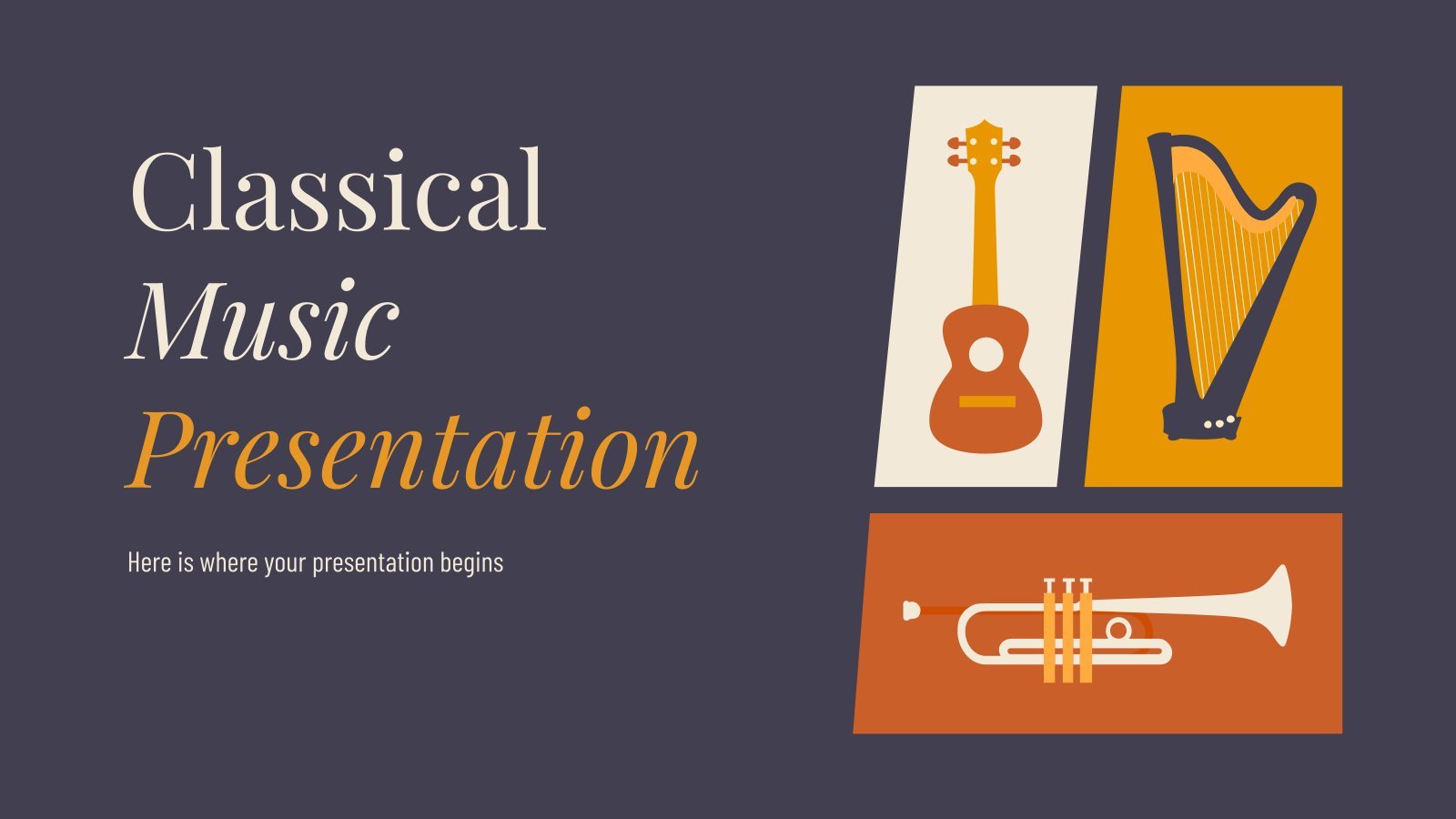
Premium template
Unlock this template and gain unlimited access
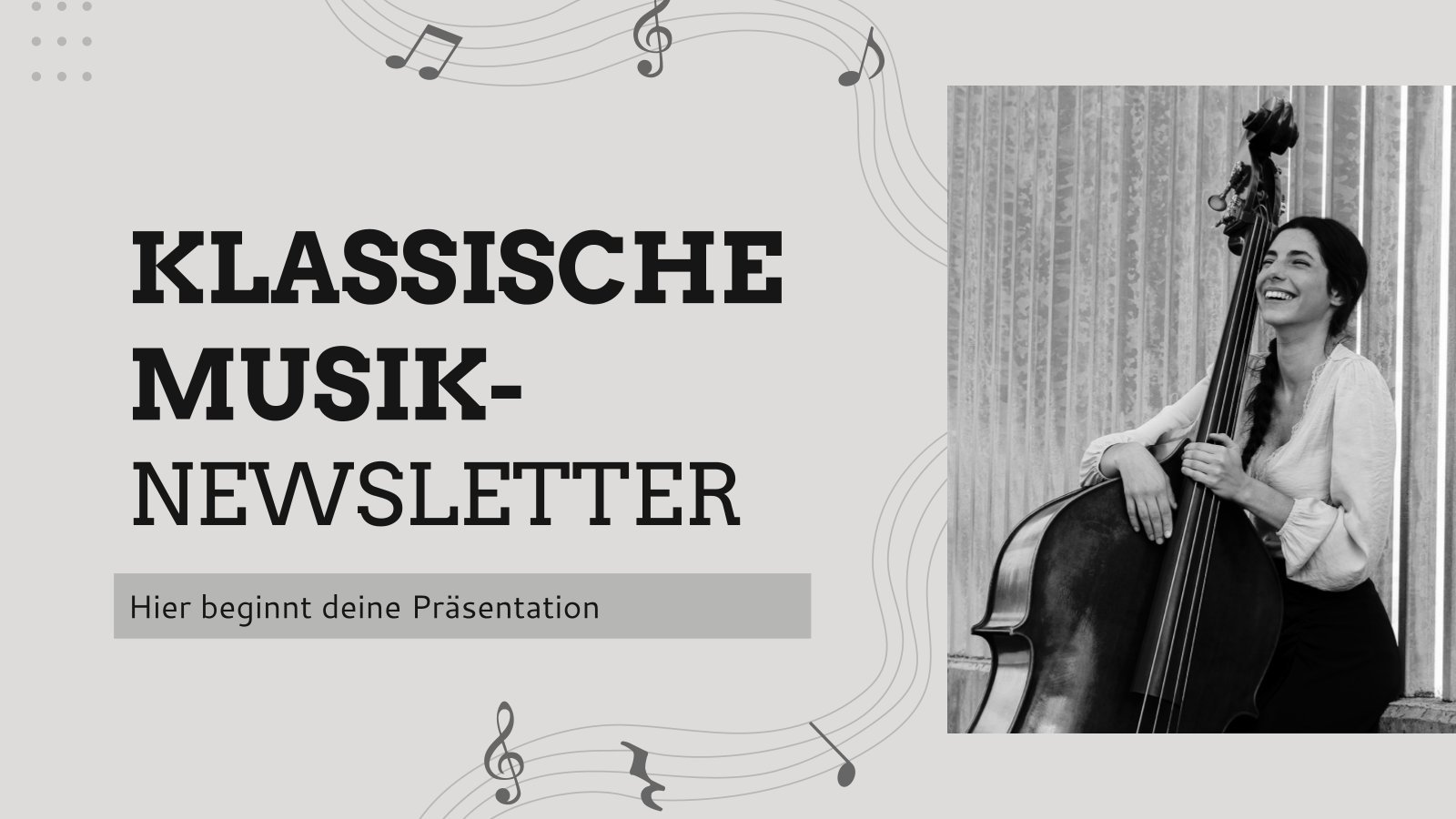
Create your presentation Create personalized presentation content
Writing tone, number of slides.
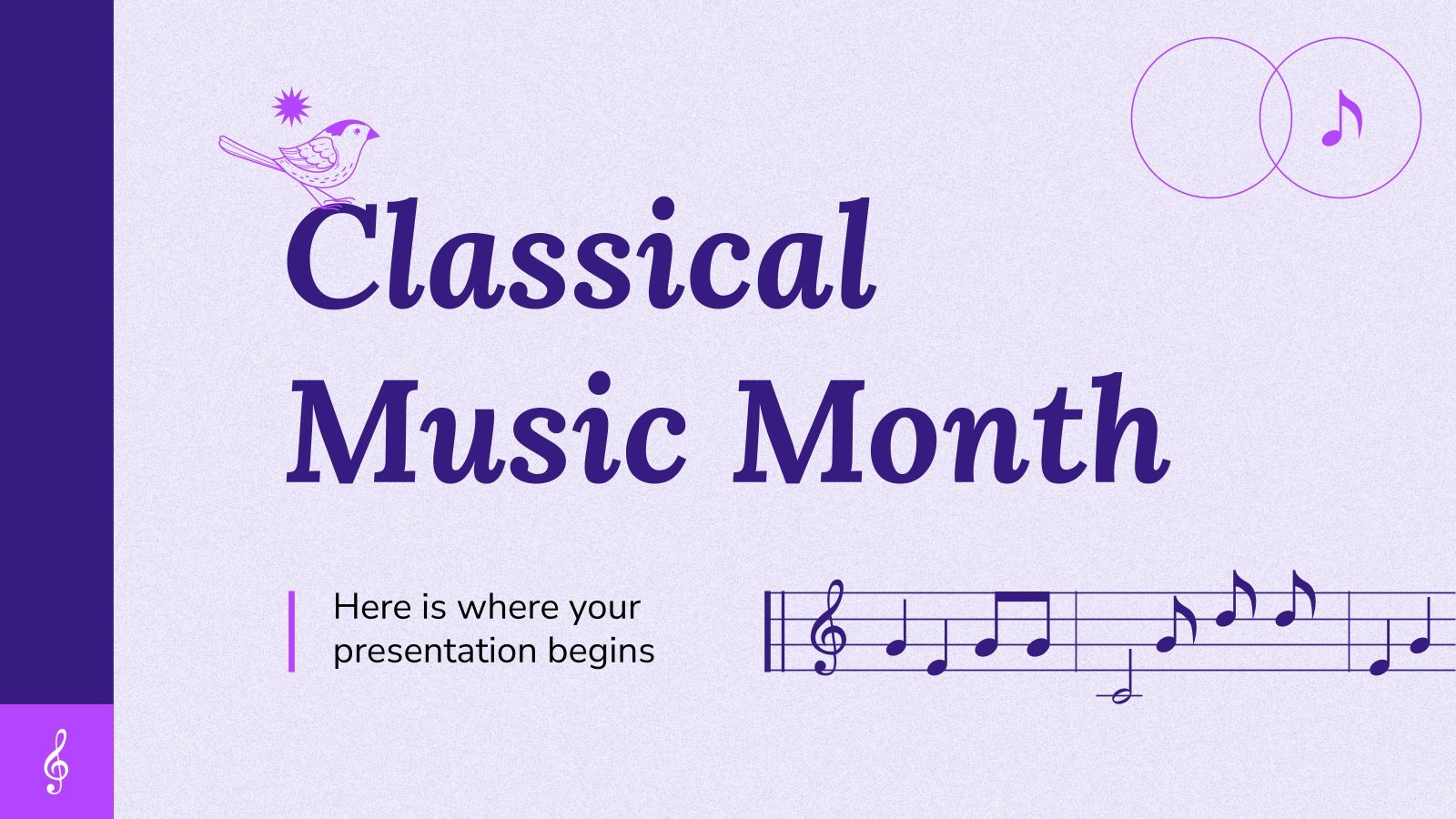
Register for free and start editing online

IMAGES
COMMENTS
Download the Music Subject for High School: German Classical Music presentation for PowerPoint or Google Slides. High school students are approaching adulthood, and therefore, this template's design reflects the mature nature of their education. Customize the well-defined sections, integrate multimedia and interactive elements and allow space ...
This is the 1st group's presentation about classical music
The transformative power of classical music | Benjamin Zander | TED TED 24.8M subscribers Subscribed 198K 7.8M views 16 years ago
How to understand and appreciate classical music? To see behind the notes and know why these great classical composers chose the notes they did and put them together in the way that they did. This academic approach to understanding Classical music provided a foundation of musical knowledge.
Free Canva presentation template From the Medieval era to the 2000s, the history of Western classical music spans nearly a millennium. In tasteful beige and brown, this elegant template lets you cover all the high points in a few informative slides.
These presentation templates are suitable for presentations related to classical music. They can be used by musicians, music teachers, music students, or anyone interested in classical music. Download your presentation as a PowerPoint template or use it online as a Google Slides theme. 100% free, no registration or download limits.
The pull of music--especially classical music—has never been explained. The aim of this course is to do just that: To explicate the mysteries and beauties of some of Western cultures greatest musical compositions—among them masterpieces of Bach, Mozart, Beethoven, Wagner, and Puccini. We begin with the elements of music, breaking classical ...
Classical Music Presentation Premium Google Slides theme, PowerPoint template, and Canva presentation template Tune your guitar and enjoy listening to classical music! This template is formal and it contains different illustrations of instruments. We have also added pictures, tables and infographics.
CrystalGraphics creates templates designed to make even average presentations look incredible. Below you'll see thumbnail sized previews of the title slides of a few of our 200 best classical music templates for PowerPoint and Google Slides.
Using a simple and enjoyable teaching style, this course introduces the novice listener to the wonders of classical music, from Bach fugues to Mozart symphonies to Puccini operas.
Classical Music Presentation. Classical music is a genre of music that has been around for centuries and continues to be popular today. It is typically characterized by its use of orchestras, choirs, and soloists, and is often performed in concert halls and opera houses. Classical music is known for its complexity, depth, and emotional range ...
Classical Music Presentation templates - Page 2 Classical music is a type of music that originated in Europe and is known for its complexity, emotional depth, and technical skill. Names like Mozart, Beethoven or Bach transcend history! Now sit down and remain in silence, because the concert is going to start.
Get inspiration for Classical Music Powerpoint Templates. Browse through our huge selection of community templates or smoothly transition your PowerPoint into Prezi. Create engaging presentations and impress your audience with your visual story.
Need to get your head down? Science suggests these are the perfect classical works for studying. Music can make or break a revision session. So, we put together a countdown of the perfect classical music to set you on the path to success.
classical music Powerpoint templates and Google Slides themes Discover the best classical music PowerPoint templates and Google Slides themes that you can use in your presentations.
Give children a lively overview of the Classical period in music history with this fun, illustrated PowerPoint. It includes: a timeline situating the Classical between the Baroque and Romantic periods; typical instruments used in Classical music - the development of keyboard and woodwind instruments; cues for listening to exemplary pieces (get these tracks ready to listen to in advance!); a ...
Download Classical Music for Presentation by MelodyLoops. Total tracks - 103
Host John Birge presents a daily snapshot of composers past and present, with timely information, intriguing musical events and appropriate, accessible music related to each. He has been hosting, producing and performing classical music for more than 25 years.
On a late afternoon in May, pop and classical music luminaries gathered in the neo-Gothic sanctuary of a 19th-century church-turned-Soho House in Stockholm.
Free Google Slides theme, PowerPoint template, and Canva presentation template Mozart, Bach, Schumann—where does a passionate music teacher even begin? With these middle school classical music slides, of course. In sensible black and yellow, these illustrative slides will support your lessons on history, theory, and technique.
The revered interdisciplinary artist, now in her 80s, remains vigorous and regards the joy of curiosity as the key to staying young.
This annual award recognizes women who have made significant contributions to the classical music art form and have inspired our listeners. Find out more! Share. Bruckner's magnificent finale. Anton Bruckner's Symphony No. 8 is a massive piece—more than 80 minutes from beginning to end. Conductor Yannick Nezet-Seguin says the symphony is akin ...
The Sounds Of Music Imagine the journey a musician might take from classical to jazz. Once upon a time, technology—when done well—was classical music, the same way that finance, accounting and ...
Classical music lifts our mood by synchronizing our 'extended amygdala' August 9 2024 Credit: CC0 Public Domain Whether Bach, Beethoven, or Mozart, it's widely recognized that
Classical music composers have long been recognized as some of the most talented and influential musicians of all time. From the beautiful melodies of Mozart to the stunning operas of Verdi, classical music has captured the hearts of audiences for centuries. Some study their lives, others study their works.
The University of Minnesota Morris announces the 2024-25 Performing Arts Series presented by the Campus Activities Council (CAC). This season features performances by AnnaRose, Ballets with a Twist, Broadway's Next Hit Musical, and ProMusica Minnesota.
MONDAY, Aug. 12, 2024 (HealthDay News) -- Does listening to classical music make you feel sublime? A new study suggests there might be a scientific reason for that: Researchers discovered that the music lifts a person's mood by improving connections between brain regions related to both sound and ...
After an exciting two and a half weeks of competition, it's time to say "au revoir" to the Paris Olympics.
Artists including the Grammy and Academy Award-winning Billie Eilish, Grammy-winning Red Hot Chili Peppers and Snoop Dogg, Southern California music icon, will perform in the celebration. Grammy, Academy and Emmy Award-winning artist H.E.R. will perform the U.S. national anthem live in Paris.
Download the "Cello in Classical Music" presentation for PowerPoint or Google Slides and start impressing your audience with a creative and original design. Slidesgo templates like this one here offer the possibility to convey a concept, idea or topic in a clear, concise and visual way, by using different graphic resources.